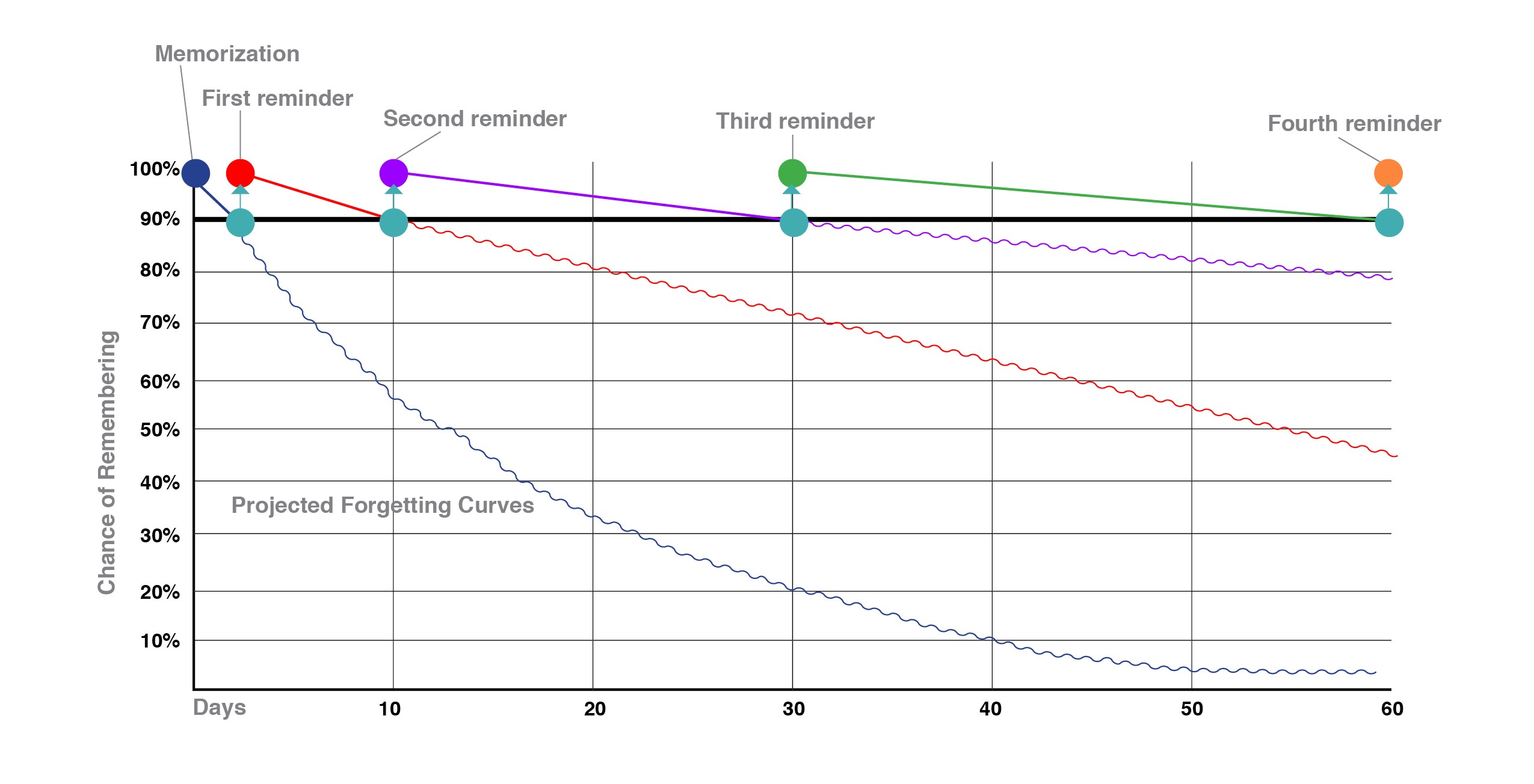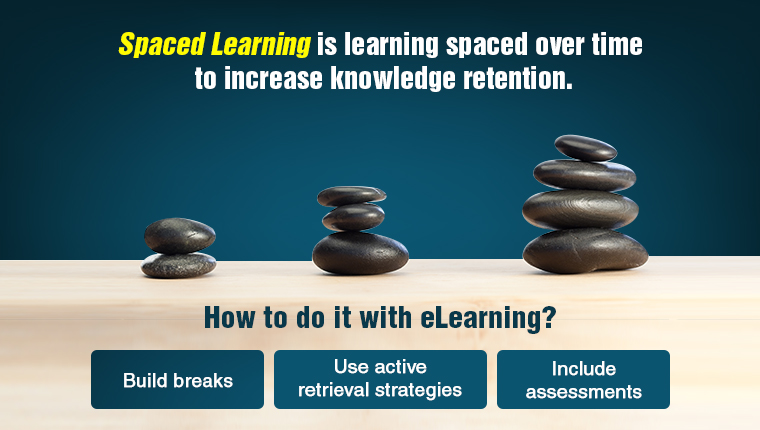Looking for Key to Retention in eLearning? Spaced Learning to the Rescue!
Looking for ways to foster effective long-term learning? Do you know about spaced learning? Implement spaced learning – know how and why in this post.

Do you remember undergoing a full day training program and instantly comprehending the content and recalling every detail even after years? Quite irrational a question, right? Well, learning is a continual process and effective long-term learning can seldom be achieved with a one-off training event. The reason being, the human brain is not designed to retain information after just reading/learning once. An individual needs time, reinforcement of learning, repetition, and different learning methods to facilitate knowledge retention.
What is spaced learning?
Spaced learning can provide a solution to fight the forgetting curve in corporate training programs. According to the principle of spaced learning, information that’s divided into bite-sized nuggets, repeated multiple times makes reinforcement of learning effective.
It is a fact put forth by leading psychologist Herman Ebbinghaus. He pointed out that humans have a definite learning curve as well as a forgetting curve. The learning curve describes the natural course of duration a new learner takes to understand a concept for the first time. Similarly, the forgetting curve shows the inevitable loss of learning that will occur when existing knowledge is not frequently reviewed for use.
Thereby, effective learning solutions are not only about helping your employees learn quickly and efficiently, but also about helping them reduce forgetting.
What Can be a Probable Solution to Tackle This?
Is your answer just-in-time performance support? Well yes, it can be one of the solutions. If a learner learns something just before he needs to apply it, there is hardly any time to forget. However, do you think all your learners will understand information equally just before they need to use it? Sometimes having to pause and look up for more information can slow down learning. Evidently, you will need an additional approach to complement just-in-time learning. You might be wondering if there is something more effective.
Venture into Spaced Learning
“Left to itself, every mental content gradually loses its capacity for being revived, or at least suffers loss in this regard under the influence of time.”
–Ebbinghaus
According to the principle of spaced learning, information can be easy to learn if it is divided into short-nuggets and repeated multiple times. Ebbinghaus also talks about the “spacing effect” wherein he says repeating chunks of information spaced over time is helpful in reducing the loss of knowledge gained and boost retention of knowledge.

Image source: https://knowledgeplus.nejm.org/
To put it simply, if you want your learners to remember and store the most important information in their long-term memory, going for spaced learning is the option. It can be characterized as:
- Short nuggets of learning, each utilizing a variety of auditory, visual, and interactive mode of learning deliveries.
- Necessary mental breaks between learning nuggets to ease assimilation of the learning content
- Scope for engagement and application to reinforce important learning and enhance retention
- Repeating information using different delivery formats to broaden comprehension and improve recall
How to Go About Spaced Learning for Online Training Programs?
Leveraging spaced learning comes with many benefits, and the steps associated with its implementation for online training are easy. Ensure you get these steps right while you aim for effective spaced eLearning for your employees.
What should be the structure of spacing in eLearning?
To begin with, it’s imperative to ensure the structure of spacing in your eLearning is right. The process entails presenting learners with courses related to specific learning objectives, allowing time to elapse, and presenting them again. You can decide the number of repetitions depending on the complexity of your learning content. Additionally, you can decide the length of breaks between learning nuggets based on the content and the learners.
How do you make repetition creative?
Since spaced learning thrives on repetition for enhanced retention, it is important to frequently repeat the core information of your training program. This might also mean repeating complex concepts more often than the basic ones.
However, repeating the concept often might involve using the same content again. This is where you can leverage different digital learning assets. It can be in the form of videos, storytelling, scenarios, simulations, practice activities, etc. This allows presenting the same content in creative and engaging ways every time.
All these methods immerse learners in the learning content as well as leave a lasting impact for better retention. The mantra is not only to repeat but also to repeat creatively.
How do you create scope for real-life application with spaced learning?
While presenting content creatively is important, providing scope for real-life application takes it a notch higher. Doing so fosters active engagement with the learning content required to achieve actual understanding.
Didactic activities such as infographics will always be an important part of an eLearning program. However, to allow real-life application, you need use assets such as simulations, group discussions, quizzes, branching scenarios, etc.
Using these online learning assets emulates the real-life situations your employees are likely to recall and remember while applying to their job roles. This in turn results in better productivity, leading to better returns on investment.
How do you encourage on-the-job practice with spaced learning?
By now I am sure you must be convinced of the competency of online learning solutions for spaced learning. While leveraging different digital delivery methods can surely provide an effective training, encouraging learners to practice their knowledge in the workplace is also important.
How to do this in online training? Using gamification can be one strategy. After all, who doesn’t like indulging in good games? This doesn’t require enormous costs as associated with developing actual games. You can do so by offering badges, rewards, and setting up leaderboards. Achieving a certain level or crossing one level will surely boost learners’ motivation in practicing their acquired knowledge.
Why Should You Consider Spacing in Learning?
You might be questioning the feasibility of spacing in learning, even more so when the training time is limited. However, there are some evident benefits of this approach that will make you reconsider what you think about it. Spaced learning:
- Reduces cognitive load for better assimilation of what is learned
- Helps beat the forgetting curve for enhanced retention and recall
- Helps learners practice newly acquired knowledge and offers realistic application opportunities
You might have noticed marketing campaigns making use of spacing and repetition for propagating key messages. Doing so helps create a ‘persuasive’ effect by cultivating a sense of familiarity – achieved through repetition. However, it’s time to take a lesson from marketing in spacing out material and applying that in training as well





